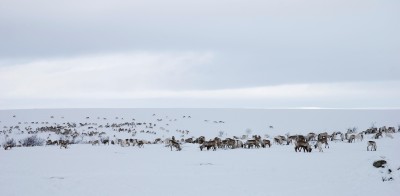Reindeer herds are leaving their winter pastures on the Finnmark plateau these days and heading for fresh grazing land along the coast of northern Norway. The annual, challenging and traditional migration is underway, with a few modern enhancements.

The new season’s calves are being born on the Finnmark plateau, while the adult males, adolescent animals and females without young are making their way to summer pastures, writes newspaper Aftenposten.
The males have three important jobs: To impregnate the females, to use their strong hooves to break the ice that covers the moss during the winter, allowing the herd to feed, and to fatten themselves in order to make money for the reindeer owners at the end of the season.
Moving the reindeer is also a major social event for the herders. The trip requires long hours and a minimum of sleep for weeks on end, yet plenty of coffee, ice fishing and good company make it a special time for owners and herders, reports Aftenposten.
The oldest bucks take the lead, remembering the route from one year to the next. The herders watch their flocks making sure they don’t get mixed in with other reindeer. When the snow freezes at night, the animals use the firmer ground to move faster, but when the weather worsens, the old males settle down and wait.
At this time each year hundreds of thousands of reindeer in Northern Norway leave their winter pastures in the mountains for new grazing on the coast. The moss in the upland areas needs time to recuperate through the summer, while lush coastal grass and other plants allow herds to grow fat.
Some of the reindeer trek more than 200 kilometres, whereas others only have to travel a short distance. Sometimes animals are transported by road, and to get to island pastures, they are ferried by boat. One major change has taken place during the last 30 years: The herders used to walk or ski, but now snowmobiles and all-terrain vehicles have become an essential part of the move.
Unseasonably warm weather on the Finnmark plateau actually has made this year’s journey especially tough. The mild weather left the snow soft, while streams turned to torrents overnight.
“No one can dictate the weather,” reindeer owner Johan S Buljo told Aftenposten. He can cope with the weather but is more concerned about protected predators like lynx, wolverine and eagles, which pick off weak animals and newborn calves.
When the reindeer stopped moving as the going got soft, Buljo had to catch one of his old bucks in order to lead it ahead of the flock. Herd instincts took over again and the animals resumed their move towards the coast. The first new birch shoots drew the reindeer on with increasing speed until after finally crossing the main E-6 highway, they raced on to the beach. The trek was over and men and animals could relax for a while.
Views and News from Norway/Sven Goll
Join our Forum if you’d like to comment on this story.

